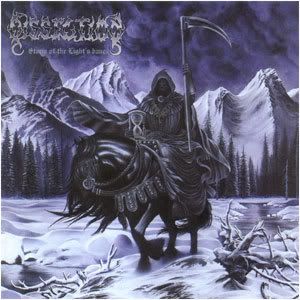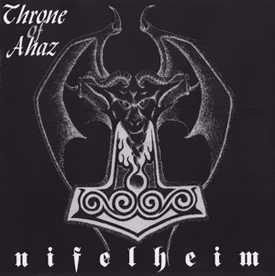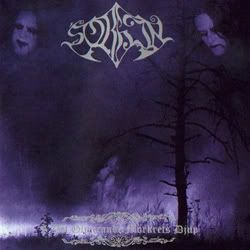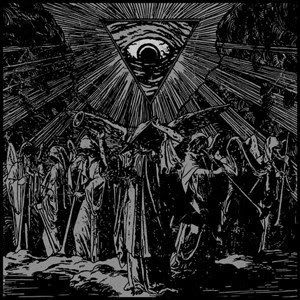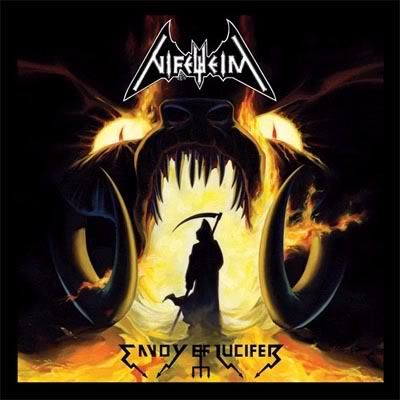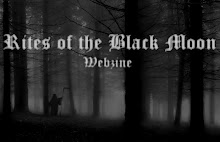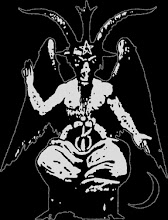Tuesday, January 29, 2008
Dissection - Storm of the Light's Bane (1995)
Tuesday, January 22, 2008
Dissection - The Somberlain (1993)
Dissection is a name that is sacred in the realm of Black Metal. Beginning in the twilight of the 1980's, this band's earliest works were rooted in the growing Death Metal scene. Hailing from Strömstad, they were quite removed from the happenings in the Stockholm scene and their sound never had anything to do with what was happening there. Though The Grief Prophecy was not the most impressive demo, one could already detect a sense of darkness that many bands were lacking. The material on Into Infinite Obscurity only solidified the band's commitment to creating music with a dark and morbid atmosphere. Being so close to Oslo, it was no surprise that Jon Nödtveidt became involved with some of the leading figures of the Norwegian Black Metal movement, particularly Euronymous. Whether due to this or just as a result of a natural progression of Dissection's black vision, their style shifted ever more toward the cold and grim Black Metal that was emerging in the early '90s. At this point, Sweden did not have much of a Black Metal scene to speak of, other than the likes of Marduk and Abruptum. In late 1993, after several delays, Dissection's debut L.P. was finally unleashed upon the world. The Somberlain established the band as one of the premier bands in the underground, not just in Scandinavia, but all over the world.
This was one of the first Black Metal albums that I ever heard and has since remained somewhat of a measuring stick against which all other albums are compared. Being in the states, I was a few years late in picking this up, and had only really become aware of the band by seeing a few Dissection t-shirts at concerts and thinking that there must be something special just based on the feeling conveyed by the artwork. Upon hearing The Somberlain, I was completely blown away. This was one of those magical albums that really managed to take me to another world, far beyond this mundane reality. During the winter months, I listened to this record over and over again, just soaking in the cold and nocturnal atmosphere conveyed by the dark melodies and the sinister vocals. Everything about this seemed to fit together, from the music and lyrics even to the cover art and the obscure photo of Bran Castle that is found inside. These guys really understood that the aesthetics needed to match the musical content in order to form a complete package.
The darkness begins to unfold from the absolute first moments, as some demonic speech is played in reverse, leading into incredibly cold and dark tremolo riffs. This guitar melody is very memorable and does well to establish a feeling of gloom. "Black Horizons" is a monumental opener, featuring somewhat of a Mayhem influence, which makes sense as the album is dedicated to Euronymous. The song structure is masterful, with each passage flowing into the next, flawlessly. Jon's vocals are even more raspy and hellish, expressing a very misanthropic and almost inhuman feeling. Near the middle of the song, there is a clean guitar section which is done in a far superior manner to anything from bands like Satyricon, sometime after this. The lead solo possesses a lot of feeling and adds something to the sound. As the clean guitars return, a sense of tension builds, erupting with a high pitched scream from Dan Swanö, followed by a woeful choir. The mood becomes even more dismal and melancholic, before returning to the main riff from earlier and moving toward its conclusion. This is a brilliant opener, demonstrating great skill in songwriting and execution, luring the listener in with a grim classic of epic proportions.
As if the first song was not dynamic enough, proving that Dissection was far above the majority of the mediocre bands that were springing up everywhere, the title track comes along to put the final nail in the coffin of doubt. From the very first notes of this majestic composition, the listener is dragged deeper into the abyss, leaving this world behind. "The Somberlain" begins with a cold and mournful riff, soon erupting into a hellish whirlwind of hatred and melancholy. While this music is much more melodic than what some other bands were doing, it still possesses a very dark feeling and never becomes 'light or weak'. It is clear than Jon knew exactly how to incorporate these black melodies in order to create a sense of gloom and morbidity. Just as the music is utterly flawless, the lyrics are among the best ever written. Everything comes together to take the listener to a world of endless winter nights, as the razor sharp guitar riffs cut through your flesh like bitter winds howling from the north. The slower section in the middle of the song is one of the highlights of the album, imbuing the listener with a feeling of incomprehensible sorrow and yet a sense of optimism at the coming of death and the knowledge that this world will soon be nothing but a shadow of a memory. There is a definite Mayhem influence, late in the song, as everything fades away and leaves only an icy tremolo riff to accompany the diabolic incantation. This is the sort of song that one does not simply listen to; this is an experience, one that will never be forgotten.
"I flew over crystal ground
My existence, numb
Over orchards of grievance,
sorrow and tears
This beautiful silence
calls me now"
After such intensely passionate (and lengthy) songs to begin the album, it only makes sense to give the listener a bit of a breather. "Crimson Towers" is a brief acoustic instrumental that allows for somewhat of a break while also fitting well into the overall arrangement of the album. It has kind of an introspective vibe, and is a perfect bridge between the previous song and the one that follows.
As the drum roll leads into the frozen guitar melodies of "A Land Forlorn", one has to be amazed with the quality of each track on this album. Rather than putting all of their effort into a handful of songs and then padding the album with filler, each song possesses a unique feel and maintains the same level of quality as the rest, serving as an integral part of the record as a whole. This is another dynamic piece, featuring its fair share of fast tremolo melodies and blasting drums, but dominated by slower riffs that convey a gloomier feeling. The transitions from one riff to the next are seamlessly done, exhibiting great skill on the part of the musicians. Much of the song has a sombre tone, with some rather sinister parts woven in as well. The band's roots in old school Metal are clear, and there may even be some Candlemass influence in some parts of this. The sense of epic doom is conveyed well during the last minute or two. It creates a sense of finality, as if you are rapidly approaching the grave and many images pass through your mind, but all in a blur as the coffin lid opens and welcomes you in. This is one of the most epic endings to any song that I have ever heard.
"Heaven's Damnation" shakes things up a little, being a bit more straightforward and faster than the previous song. While still dark, the atmosphere is not quite as obscure as before. Rather, this is just evil and cold. Jon's vocals possess a rather urgent feeling, being delivered in an intense tone. As with the whole album, the musicianship on display is fantastic and proves that Dissection were leagues beyond many others that were pumping out cheap albums around this time. The '80s roots are detected again, as some of the riffs have kind of a traditional Metal feel, despite being played in the Black Metal style. Compared to some of the other songs, this is structured in somewhat of a more direct manner, yet still includes a strong variety of ideas and is no less memorable than any other song on here. The slower part in the middle helps to maintain the same dismal feeling that pervades much of this record, soon leading into a riff that sounds somewhat inspired by old Bathory. It ends with a brief acoustic passage that might not seem like much, yet really adds something to the overall effect. Little things like this are able to make such a difference, whereas most other musicians wouldn't have even thought to include that.
The next song is another favourite and proves to be yet another classic among many. "Frozen" is one of the shortest proper songs on here, yet is it just as effective as the eight-minute epics. Aptly titled, the guitar melodies are ice cold and maintain a feeling of utter darkness. The lyrics deal with vampyric themes, yet are go in the total opposite direction of inferior bands that attempted to touch on this topic. It really ties in well with the misanthropic and hateful tone of the rest of the lyrics on this album. This is a fairly straightforward song, still possessing the same nocturnal feeling as the rest and being one of the more memorable compositions on here. This is a perfect example of what Black Metal should sound like and makes one wonder how in the world some dimwits ever called this Death Metal or even 'blackened Death Metal'.
"Far beyond all light
Within the black and the coldest breeze
Caressed by the dark, I had my sleep"
Another acoustic interlude follows, giving the listener a chance to gather themselves after such an intense barrage. "Into Infinite Obscurity" is strong enough to stand on its own, but works best within the context of the album as a whole. The feeling is not as oppressively dark as some of the other material, here, allowing you to get a sense of where you are before the fog rises again.
"In the Cold Winds of Nowhere" starts out with doomy bass line and a guitar melody that instills a sense of dread, creating an image of ravens circling above ancient ruins, high in the moonlight sky. Though clocking in at over four minutes, this song feels way too short in some way. This is a good contrast to songs of similar length that seem as if they take forever. The listener is able to get caught up in the sorrowful atmosphere as the cold and gloomy melodies become embedded in the mind. Several different paces are utilized, only reaching top speed for a brief time. The lead solos, as usual, fit the music very well and add to the dreary aura, unlike many other bands that either ignore the use of solos or toss in meaningless ones as if fulfilling some requirement.
The doom element is again present in the intro to "The Grief Prophecy / Shadows Over a Lost Kingdom". It's too bad that this was dropped on the following album, as these sections really help add to the dark feeling and make the compositions feel all the more epic in nature. Despite its short length, this song still includes various time changes that feel natural and flow well. Sounding much more crisp than the demo version, the melodic riffs do well to carry on the majestic and nocturnal feeling. The production on this whole album is very good, being clear enough for everything to be heard as it should be, yet still retaining an underground feel and never getting to the point where it sounds unnatural.
The final song is "Mistress of the Bleeding Sorrow". It features another classic Black Metal riff in the beginning, before transitioning to a doom riff and featuring a solo that is reminiscent of Diamond Head's "Am I Evil?" for some reason. This song remains somewhat slow and mournful throughout much of its four and a half minutes. Of course, the album couldn't end without things speeding up one last time, near the end. This mini-epic is a great closer, though it sort of falls short of what one might expect, considering the way the album began. The album then draws to its conclusion with the instrumental, "Feathers Fell."
The Somberlain is an undisputed classic of Scandinavian Black Metal, forever earning a place among the likes of De Mysteriis Dom Sathanas, Under A Funeral Moon, Pure Holocaust and Det Som Engang Var. As a matter of fact, it may very well rank slightly above most of these albums. With memorable riffs, an undeniably dark and morose atmosphere and genius songwriting, Dissection proved to be among the elite and cemented themselves as the most important Swedish band to come along since Bathory. Nödtveidt and Zwetsloot display an incredible sense of melody and show that this can be incorporated into such music without making it light or happy. Ohman's skilled drumming places him among the best in this field, as well. This is cold, nocturnal Black Metal that is filled with hatred, sorrow and pure evil; a record that is permeated by an overwhelming lust for death and total removal from this world. This is a mandatory release for anyone into the Second Wave sound. If you don't own this, kill yourself.
Throne of Ahaz - Nifelheim (1995)
Nifelheim continues with the title track, beginning with the sound of freezing winds blowing across the dismal land. The song begins with a mid-paced thrash riff that crushes your feeble spirit like Mjöllnir, itself. Lyrically, this is not too far from the themes used by Immortal.
Sorhin - I Det Glimrande Mörkrets Djup (1997)
This is another lesser-known gem from the Swedish Black Metal scene, being Sorhin's debut full-length. Scathing, hateful vocals, sharp guitars and blinding speed assault the listener from the very beginning of "Godhetens Fall" and it does not let up. I discovered this on a freezing Winter day, and I think this was a very appropriate time to do so.
The sound is more reminiscent of early Dissection, without really sounding like them at all. By that, I mean that the sense of melody reminds me more of the early Norwegian bands rather than the blasting, lifeless sounds of some of the better-known bands. Their use of Swedish lyrics is also very fitting, as this language suits the music quite well.
While there are tempo shifts, the fast-paced songs dominate until we arrive at "Svartvintras" ("The Black Winter") which is slower and has almost a Burzum-like quality to the main riff. Of course, this song speeds up as well, but it is not without feeling. As much as I loathe to admit it, the vocal delivery here is quite similar to Satyricon's The Shadowthrone. Luckily, this is a much more solid album than that and is not plagued with worthless keyboards to act as a crutch to create atmosphere. Actually, upon closer inspection, the vocals are also reminiscent of Ritual, from Master's Hammer.
There are many great melodies on this album, some violent and some mournful. The Swedish lyrics tell of death, darkness and hatred for Christianity. Really, nothing groundbreaking in that department and there's no need for it to be any other way. The production was done by Peter Tägtgren in Abyss studios, yet it doesn't have the annoying sound that many of his later efforts have. Everything was done well enough and I can't really complain about the production. While I would not call this a classic album or rate it up with The Somberlain, I can recommend this as a solid piece of Black Metal history. There are some great riffs contained in this album and if you manage to run across a copy, definitely pick it up.
Sunday, January 20, 2008
Watain - Casus Luciferi (2003)
From the first moments of "Devil's Blood", one is taken back in time and dragged into a darkness that was often forgotten in the decade that preceded it. Eerily similar to the melodies from the title track of De Mysteriis Dom Sathanas, one could either look at this as a rip-off or a tribute. The haunting tremolo riffs and morbid vocals come together to create a hellish and gloomy atmosphere. There is something urgent about this, as the listener is being carried into the depths of hell. Far from being one-dimensional, the songwriting displays a good sense of structure and it rather dynamic. As with Mayhem, the bass is just audible enough to add to the sombre vibe. The cold and nocturnal guitar melodies continue with "Black Salvation", which is one of the better songs on here. The vocalist sounds possessed by some ancient demonic force, giving the image of some entity that has recently forced its way out of a rotten coffin and crawled back through the damp soil. Though including some mid-paced parts, this song blasts ahead at a frantic speed for the most part, as well.
The next couple songs are not quite as memorable, though no less intense and well-written. "Opus Dei" and "Puzzles ov Flesh" work within the context of the album as a whole, but are not likely to be songs that one would return to for repeated listens. Still, a grim and occult atmosphere is present and these tracks are filled with hatred and blasphemy. The cold riffs and gloomy bass lines do well to fill your mind with morbid images. Unlike so many modern bands that rely on keyboards and still fail to create any kind of real atmosphere, Watain succeed in doing so using conventional means. It is hard to believe that this band hails from Sweden, as this is far superior to the trash being spewed out by the likes of Marduk and Dark Funeral in recent years, while also killing the sometimes-mediocre efforts by bands such as Armagedda.
"I Am the Earth" is a dynamic song that bridges the two halves of this album, starting out rather fast and including some more intense parts later on, but being dominated by guitar riffs that are very reminiscent of early Burzum and Mayhem's "Life Eternal". As with the rest of the album, there is an undeniably morbid feeling that one gets from listening to this, even the echoes sound as thought they are echoing from some forgotten grave. The latter part of the song possesses somewhat of a melancholy vibe that serves to drag your spirit down deeper. This is accentuated by the following track, "The Golden Horns of Darash". The slower parts that dominate much of the song really hearken back to classic Mayhem, while the faster riffs add a sense of desperation. However, this is another song that really works best while listening to the album in its entirety, rather than as a stand-alone track. The listener is being taken on a dark journey through the blackest shadows and into the mouth of hell, itself. The tension builds more and more during each song, as we near the end of all things.
One of the most memorable melodies of the album begins "From the Pulpits of Abomination." The explosion of demonic voices sounds as if the final barrier has been broken and the listener now realizes that there is no return. The tension continues to build as the melodies carry you into the darkness that is eternal. Now, it is too late. One can hear the cries of the damned souls that have gone before. From this place there is no escape. The cursed ones suffer in torment for all time. There is an urgency in the riffs that comes through perfectly. Everything is well-executed and done with precision. For the most part, this track is fast-paced and carried forth by cold tremolo melodies, though a weird section appears late in the song that sort of derails things for a bit. However, the climax is so brilliant that one forgets this misstep.
Thunder and rain begin the final song. Satan's bell chimes your final doom. This is, of course, reminiscent of the song "Black Sabbath" by the band of the same name. But this is much darker, indeed. This is the culmination of that legacy began so many decades before. "Casus Luciferi" imbues the listener with horrid and twisted visions of torment and hell. This is certainly the legacy of Mayhem and Dissection seen to macabre fruition. The slow, doomy riffs inspire the listener with dread as the fast tremolo melodies increase the tension and unleash the fury of hell; a fury that will not be denied. The blasting drumbeats carry the listener forward on a path unknown. As the song comes to an end, as the melody fades into the storm of wrath, you realize that is was just a dream; this was but a mere glimpse of the fate that awaits. Utter damnation and desolation. A nightmare come to life. One to be feared by the weak for the rest of their days. Knowing that, sooner or later, it would come to pass.
Casus Luciferi is colder, darker, more sinister and hateful than most of its contemporaries. With this album, Watain picked up from where Mayhem left off and created the type of Black Metal album that many have been waiting for in all the years that have passed since the demise of Euronymous. With a better sense of composition than many bands that have tried to keep the old spirit alive, as well as production that is just clear enough to allow for the riffs to be fully appreciated while still being harsh enough to embody the underground spirit of their forebears, Watain have here succeeded in doing that which few others have even attempted. To follow the path of Darkthrone or Burzum is something rather common, yet for a band to finally attempt to recreate the brilliance of De Mysteriis Dom Sathanas is quite rare. It may not be entirely original, but there is some value in keeping the black flame burning in these dark times. If you are a fan of classic-era Mayhem (or The Somberlain, for that matter), seek this out.
Tuesday, January 15, 2008
Nifelheim - Envoy of Lucifer (2007)
Envoy of Lucifer is the fourth full-length from Sweden's Nifelheim. Like many others, I've been waiting for the follow-up to Servants of Darkness for several years. At certain points, I had wondered if the band had hung it up, as seven years is a long time to go between albums.
From the very beginning of "Infernal Flame of Destruction" I knew that this was a classic Nifelheim album. With each release, this band seems to get better and better. These guys show that, unlike their contemporaries, they have a very good background in metal as a whole. Their love of Iron Maiden has been well documented. Surely, this has influenced their sense of melody as I'd say this album owes as much to Maiden as it does to Bathory. The old-school Black Metal that Nifelheim are known for has never been stronger.
The first two tracks are strong and fast-paced, and do well to set the tone for the album. However, there is much more to look forward to than blinding speed and killer solos. "Open the Gates of Damnation" is the first stand-out track (excluding the opener, which is really great as well). This song begins somewhat fast, but progresses very nicely and the old feeling is captured very well in the chorus of the song. I'm always amazed at their ability to write such awesome riffs that belong on an 80s release. Years ago, when I first heard Nifelheim, I thought I'd stumbled upon some rare band from the 80s until learning the truth.
Of course, one would expect it to be difficult to follow up such a good song with something of equal quality. Most bands have a few decent songs, separated by filler. Not in this case. Nifelheim continue forward with "Claws of Death" which really slows things down a bit, after the initial speed in the beginning, and creates a very morbid atmosphere. The tempo goes back and forth and the melodies are incredible. This is truly the legacy of Bathory and Tormentor.
Just when it seems that the album has hit an early peak, "Storm of the Reaper" gives all the justification necessary for taking such a lengthy absence in between albums. The main riff of the song is brilliant and the arrangement could not be better. This proves to be yet another high point for the album. The following songs continue on, each easily identifiable from the rest. The intro to "Raging Flames" has Maiden written all over it.
"No More Life" begins with an eerie riff, and a sense of dread; of impending doom, fills the night. As usual, the song includes excellent riffs and melodies which wouldn't be out of place on an old Bathory or Maiden album. This song is yet another highlight of the album, and is a perfect was to close out an album which is destined to be regarded as a classic in the years to come.
All in all, I cannot complain about this album. The production suits it just fine. The vocals are excellent and the riffs are of high quality. This is how Black Metal should be. Many bands spring up after hearing a random album from the second wave and they move on to assume that they know all there is to know, yet their music will always betray their ignorance. Nifelheim's roots are in the old 80s bands, and it shows through very clearly. This is the only way it should be.
"This album is not only music. It is a ritual. Listen and receive..."
.jpg)
